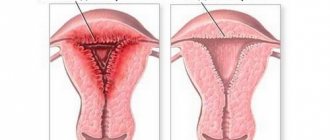Free consultation with a doctor by phone
Surgical abortion is performed in the clinic daily by appointment!!!
LLC "Your Doctor"
Addresses of medical centers in Moscow (unified reference) +7 (495) 255-45-59
Make an appointment at the clinic
- +7 (495) 255-45-59
- Gynecological centers in Moscow
- Every day from 9.00 to 20.00
- call me back
Surgical cleaning after a medical abortion is necessary if the fertilized egg has not been completely removed from the uterine cavity. This condition is very dangerous, since its consequences can be infection and critical blood loss. Therefore, when deciding to terminate pregnancy with the help of special medications, this risk should be taken into account.
Elimination of negative consequences by curettage is required only when the pathological condition is confirmed by the results of an ultrasound examination. Sometimes cleaning can lead to various kinds of complications. You can avoid them by regularly visiting a gynecologist and performing all the required tests.
https://youtu.be/2aaufQ7Y_lE
Useful information on the topic:
- Medical abortion
- Pregnancy pills
- Contraindications to medical abortion
- Menstruation after medical abortion
Uterus after abortion
After an abortion, a woman expects a fairly long recovery period, which largely depends on the method that was used during the procedure, as well as on compliance with all the recommendations of the female doctor. The first thing that happens in the body of a failed mother is the contraction of the uterus and its cleansing of secretions. This process is normal and lasts from several days to a week. During this period, the restoration of the endometrium, the mucous membrane lining the uterine cavity from the inside, begins actively. The duration of complete restoration of the endometrium is about a month, since a wound forms at the site where the fertilized female reproductive cell was attached after an abortion. The fastest recovery occurs after an abortion performed using vacuum aspiration.
picture taken from To Truth
Termination of pregnancy using vacuum aspiration is most often carried out in the period from 7 to 9 weeks of gestation, since during this period the embryo has already managed to attach to the wall of the uterus. If this method is used for abortion, damage occurs only to the area of the uterus where the fetus was directly attached. The duration of the procedure is only a few minutes, while the woman experiences minimal impact. After the manipulation, the myometrium begins to actively contract, causing pain. 5-6 days after surgery, the uterus returns to its original size.
When medications are used for abortion, the recovery period will be quite long. This is because the drugs used to terminate pregnancy are considered safe, but they also have negative effects on the body. For medical abortion, a characteristic pathological phenomenon is a hormonal imbalance, therefore, when using this method, a woman needs to learn about all the possible complications that may arise after terminating a pregnancy in this way.
The longest recovery of the uterus occurs after instrumental or surgical curettage. In addition, this method has a huge number of complications that can arise after the procedure.
Features of the recovery period after abortion
Immediately after an abortion, the uterus contracts and gradually decreases in size. At this time, due to the fact that the cervix remains open for several days, it is possible to cleanse its cavity. Complete restoration of the uterine mucosa (endometrium) occurs gradually over several weeks.
The duration of the recovery period after an abortion is largely determined by the chosen method of termination of pregnancy. According to statistics, recovery occurs fastest and with the least complications after a mini-abortion performed in the early stages. The procedure itself is quite quick and takes no more than 10 minutes, and if it is performed by an experienced doctor using ultrasound, complications occur in rare cases.
As a rule, the doctor gives recommendations regarding whether it is possible to take antibiotic medications after an abortion to prevent the development of infection against the background of a weakened immune system and other drugs for the symptomatic treatment of possible complications after the abortion.
Medical or medication abortion is considered safe by many estimates, although the medications used can cause a variety of side effects. It is after this method of abortion that the recovery period can be quite long, since hormonal levels change. These medications also affect many other systems of the body, which can affect the woman’s overall health.
After the procedure, be sure to ask your doctor about the possible consequences. This is necessary in order to know why certain complications arise after an abortion and how dangerous they are.
Quite often, after a medical abortion, the pregnancy test is positive. This may be due to various reasons. Sometimes hormonal levels are restored gradually. This can be judged by the positive dynamics of tests for the content of the hormone produced during pregnancy (chorionic gonadotropin). You can find out more precisely why the pregnancy test is positive after an abortion only from a doctor after conducting additional research. Sometimes this is due to an incomplete or failed pregnancy, then an abortion will require another method of abortion. These factors influence how long the recovery period will take and what complications may arise.
Surgical abortion is considered the most dangerous of all types. Accordingly, recovery after it can be the longest, and the consequences for a woman’s health will be more severe.
Discharge after abortion
After an abortion, the appearance of moderate discharge with a small amount of bloody clots in it is quite physiological and characteristic of this process. The duration and amount of leucorrhoea largely depends on the method that was used to terminate the pregnancy.
If instrumental abortion is used, the discharge will be more abundant and intense than with vacuum aspiration. This is justified by the fact that when using the latter method, trauma to the uterine cavity is minimized.
When spotting after an abortion has a different consistency, the woman needs to visit a gynecologist who will examine the uterine cavity.
Often, after an abortion, a woman’s general condition is very weakened. The occurrence of weakness is mainly accompanied by bleeding from the uterine cavity, which can last up to two weeks. After their complete disappearance, the woman needs to go to the gynecologist. Prolonged discharge may signal the occurrence of a placental polyp or the remains of a fertilized egg in the uterine cavity. A bad sign is also a rapid cessation of discharge or its complete absence. This picture indicates an unfavorable outcome of the manipulation, because normally a woman’s uterus cannot contract so quickly. The main reason for the rapid end of discharge is often a spasm of the cervical canal, so all the blood accumulates in the uterine cavity and does not come out. In order to eliminate the problem as quickly as possible, medications can be used or the uterine cavity can be re-cleaned.
Possible complications
The consequences and complications can be very serious, ranging from prolonged bleeding to inflammatory processes and even sepsis. Complications are divided into early and late. Early ones are observed immediately after an abortion or miscarriage, and include:
- discharge;
- penetration of infection;
- chronic inflammation of the uterine cavity.
Late complications can occur several months or even years after the abortion. These may be adhesive processes, hormonal disorders, as well as deterioration in the functioning of the reproductive sphere.
Pain after abortion
After the manipulation, a woman may feel pain in the lower abdomen, which provokes discomfort, but does not change her usual lifestyle. If the pain becomes stronger, the woman needs to consult a specialist, because severe pain may be a signal of the occurrence of the following pathological processes:
- The development of hematometra is an excessive accumulation of blood in the uterine cavity, which can be caused by the remnants of the fertilized egg. In this situation, the pain will be sudden, very sharp and will have a cramping nature.
- The occurrence of an inflammatory process caused by latent sexually transmitted infections. Inflammation is often accompanied by aching pain and an increase in body temperature.
When a woman undergoing an abortion is bothered by pain in her back, or more precisely in the lumbar region, the cause of the pain may be excessive physical exertion. We should not forget that a slight nagging pain in the back is a completely physiological phenomenon that is typical for this manipulation.
Recovery after abortion
Regardless of the method chosen to terminate the pregnancy, there are a number of generally accepted recommendations that will help you recover as quickly as possible after the procedure. The first thing to do is to completely abstain from intimacy for several weeks. To improve your general condition faster, you can rest as much as possible and avoid stressful situations as much as possible. In addition, all physical activity should be avoided, as severe overstrain of the abdominal muscles can lead to bleeding.
The main recommendations from doctors after an abortion are as follows:
- twice a day it is necessary to perform hygienic procedures for the organs of the reproductive system;
- regularly change sanitary pads and wear underwear made from natural materials to avoid the growth of bacteria and the subsequent development of infectious and inflammatory diseases of the pelvic organs;
- It is strictly forbidden to use tampons after an abortion;
- You should not drink alcoholic or low-alcohol drinks, as they interfere with the full contraction of the uterus.
By following all the recommendations of specialists, the restoration of the organs of the reproductive system will go much faster.
Abortion is the artificial termination of pregnancy by medication or surgery. This is an effective and necessary procedure, however, it is traumatic for the body and can have some unpleasant consequences, regardless of the method by which the interruption was performed.
It causes quite significant changes in the organs of the reproductive system. This article describes how the uterus changes after an abortion, what happens to it, and how long it takes to recover.
Complications of abortion and consequences after abortion: what are they?
Complications after an abortion, unfortunately, are common. Ideally, after an abortion, the uterus should return to its place within a week, especially if the woman has not given birth and her body is young and healthy. However, each type of artificial abortion has a different effect on the female body.
Complications of abortion include
- injury to the female genital organs,
- infection,
- ovarian dysfunction,
- bleeding,
- also a number of psychological problems.
- Some women may develop blood clots in their veins due to bleeding disorders and blood clots entering the bloodstream after an abortion.
- Often, after an abortion, a woman develops infectious diseases. If the infection is not recognized and treated in time, chronic inflammation of the uterine appendages may occur. In this condition, an ectopic pregnancy can occur. Due to injuries to the cervix, subsequent pregnancies may end in premature birth and miscarriages.
Rare complications of abortion include sepsis.
Menstrual irregularities as a complication of abortion
The most common complication after an abortion is menstrual irregularity. 12% of women who have an abortion subsequently develop irregular periods. Lack of menstruation occurs due to the disruption of the inner lining of the uterus to restoration; this very often happens when the uterus is curetted.
In this case, not only the fetal egg is removed, but also injury to the deep layers of the endometrium, sometimes even the muscular layer of the uterus.
Subsequently, suppression of ovarian function occurs, which leads to disruption of the menstrual cycle, as well as to the development of adhesions.
Uterine complications of abortion
During an abortion, the uterus suffers more than all other organs. In the first days after surgery, inflammation may occur. Inflammation most often develops in the uterus (metroendometritis), fallopian tubes, and can occur in the abdominal cavity and in the periuterine adipose tissue.
Abortions, especially repeated ones, lead to changes in the uterine mucosa. This often becomes the cause of various menstrual disorders, as a rule, menstruation is very heavy and painful.
Not many people know that perforation of the uterus during an abortion can lead to pelvic abscess, blood poisoning and death. If the doctor uses a curette to scrape too deep a layer of the lining of the uterus, especially in areas where the uterus meets the fallopian tubes, a fallopian tube blockage may occur. If this is a complete obstruction, the woman will be infertile.
Bleeding as a complication after abortion
Each woman releases blood differently after an abortion. Some have spotting and slight discharge, while others have heavy discharge, like during a full period. And still others start bleeding.
The main thing is to understand that discharge after artificial termination of pregnancy is an integral part of the rehabilitation of a woman’s body.
This occurs because the removal of the embryo, in any case, occurs with damage to the walls of the uterus, where there is a huge number of blood vessels. In this case, post-abortion treatment is unnecessary.
In rare cases, complications are quite serious and the woman has to be observed in a hospital, given IVs and injections, prescribed pills, and physical therapy.
Early consequences of abortion occur either already during the operation or literally immediately after it. This may be uterine bleeding, damage to the uterus, adnexitis and endometritis, as well as inflammation of the peritoneum. The most dangerous complication is a puncture of the uterine wall.
Such a puncture can lead to damage to the intestines, blood vessels, and bladder. In this case, emergency medical assistance is needed.
Bleeding from the uterus sometimes occurs due to problems with uterine contractility, remnants of the fertilized egg, or a small piece of placenta that remains in the cavity after an abortion.
If a fertilized egg remains in the uterus or there are chronic foci of infection in the body, various inflammatory diseases occur.
Symptoms of an inflammatory process in a woman’s genital organs are manifested by cutting pain in the lower abdomen, high fever, bloody discharge with an unpleasant odor, general weakness, nausea and vomiting.
Late consequences of abortion
Complications after an abortion may not arise immediately, but after some time. Sometimes months or even years pass. Late complications include:
- exacerbation of chronic diseases of the pelvic organs,
- hormonal disorders,
- endometriosis,
- infertility,
- spontaneous abortion,
- complications during pregnancy and childbirth.
Most often, women undergo a surgical abortion, which is performed with surgical instruments when a curette and dilators are used.
When the uterus is forcibly expanded, its tissues are damaged, which subsequently leads to various cervical diseases and miscarriages.
A curette is used to scrape the uterus, and unfortunately, sometimes they scrape off not only the layer that will recover over time, but also the basal one.
After curettage, adhesions also often form in the uterine cavity. In the future, this will affect the course of a long-awaited pregnancy, there may be
- abnormalities in the location of the placenta,
- intrauterine growth restriction,
- violation of uterine contractility,
- and, as hard as it is to talk about it, infertility.
When a woman decides to terminate her pregnancy, she has little interest in the consequences of abortion for the body. Its main goal is to terminate an unwanted pregnancy. And the consequences after an abortion can be very serious, for example, during an abortion, a woman may begin to bleed. If the medical staff cannot give a woman a transfusion, death is inevitable.
Leaving aside the issue of the ethics of abortion, later in the article we will talk about the consequences for the body and treatment after an abortion.
Not many people know that abortion is the most common cause of gynecological diseases. Almost every fifth woman experiences early or later consequences after an abortion.
The consequences of an abortion, if the pregnancy was terminated on the day of treatment, can be generally catastrophic. Because in this case, the woman does not have time to undergo a full medical examination before the abortion.
Consequences of medical abortion
If you decide to have an abortion, you should not put off visiting a doctor, since the safest abortion today is medication. True, this type of abortion is only suitable for those women whose pregnancy is up to 9 weeks. Abortion is a serious step not only from the point of view of women's health, but also from a moral point of view.
Often, even without serious physiological problems after experiencing an abortion, women have serious psychological problems. Therefore, think carefully about your decision before going for an abortion.
Complications of vacuum abortion
This operation is called expansion with curettage. Sometimes the doctor will use a rounded knife to do the final curettage.
Consequences and complications of late abortion
Abortion can also take place at a later stage. If you are more than 12 weeks but less than 24 weeks pregnant, you may have a dilatation and removal abortion.
At such a time, the fetal body cannot be removed with a pump; completely different tactics are used. Dilators are inserted into the cervix a day or two in advance to ensure the necessary expansion.
When the cervix is sufficiently open, the doctor removes parts of the embryo's body with forceps.
For periods of more than 20 weeks, dilation and extraction abortion is used.
- The woman is in the hospital for 3 days.
- During the first two days, the cervix dilates, and at the same time the woman takes antispasmodic medications.
- On the third day, the woman takes a pill that stimulates labor.
- During the process, an ultrasound scan is performed to determine the position of the child.
- The child's legs are grabbed with forceps in order to be pulled out, leaving only the head inside.
- The instrument is then used to make a hole in the child's skull, releasing the contents.
- After the baby's head is destroyed, it is pulled out of the uterus completely.
Surgical abortion is always performed under anesthesia. Any type of pain relief during an abortion is a risk to the woman’s life. During anesthesia, respiratory arrest, cardiac dysfunction, and heart rhythm disturbances may occur. The most dangerous complication of anesthesia is allergic shock.
Complications after an abortion may not appear immediately, but months and sometimes even years later.
When deciding to have an abortion, you need to clearly understand that such an operation exposes the female body to severe stress; in addition to physical damage, the woman receives psychological trauma.
Condition of the uterus
It is the uterus that suffers the most during this manipulation. This is due to many reasons. With the surgical type of interruption, most of the manipulations are performed almost completely “blindly” (albeit under the control of equipment). For this reason, even a very experienced doctor can slightly damage the organ cavity due to the individual characteristics of the position and structure of the organ. In addition, the procedure itself often involves trauma, for example, curettage is carried out by removing the endometrial layer to which the embryo is attached.
Condition of the cervix
In addition to damage to the uterine cavity, the cervix may also be damaged after an abortion. This happens most often in cases where the fertilized egg is large enough. Cervical ruptures may occur, which later become scarred quite roughly, which complicates the next birth process. But this is precisely a pathological exceptional case, and not a situation typical for any abortion.
A typical situation for any abortion is the destruction of the cervical mucus plug in the cervix. In addition to the fact that this plug reduces the likelihood of pregnancy, it also protects the uterus from infections. When this plug is missing, the likelihood of infection entering the uterine cavity becomes very high. Endocervicitis may develop.
Therefore, during the recovery period, it is very important to carefully monitor hygiene, avoid the use of vaginal medications (or in consultation with the doctor), and avoid bathing, swimming, and sexual intercourse.
Abortion after conization of the cervix
Is it possible to have an abortion after performing such a procedure on the uterine cervix? It is often contraindicated due to the risk of extensive uterine bleeding. Sometimes instrumental abortion is not possible at all.
Abortion is the artificial termination of pregnancy by medication or surgery. This is an effective and necessary procedure, however, it is traumatic for the body and can have some unpleasant consequences, regardless of the method by which the interruption was performed.
It causes quite significant changes in the organs of the reproductive system. This article describes how the uterus changes after an abortion, what happens to it, and how long it takes to recover.
Possible damage to the uterus
What complications can arise during this procedure?
- One of the most unpleasant and dangerous conditions is perforation of the organ body during surgical cleaning. It manifests itself as pain and severe bleeding even 5-6 hours after the procedure. Therefore, it is very important to monitor your well-being in the first days after the procedure, and, if necessary, immediately visit a specialist;
- Cervical rupture is an uncommon complication that can still occur occasionally. If it is small, it can heal on its own, but a scar is formed, which can complicate further childbirth;
- Rupture of the uterine body may be rare, but it is a fairly serious condition that can potentially lead to removal of the organ;
- With frequent abortions, the walls of the organ become thinner, which leads to the fact that when planning a pregnancy, the embryo is not able to implant there. In this case, infertility may be diagnosed.
It is worth noting that injuries during abortion are currently more rare than common. The procedure is more or less safe, it is considered simple and routine, is performed quickly and does not require actual hospitalization. The woman is only transferred to the ward while she recovers from anesthesia.
What to do if you have a fever after an abortion
If hyperthermia persists for more than 3 days in a row or occurs several days after the abortion, it is necessary to do an ultrasound and a general blood test. With the results obtained, you need to see a gynecologist to determine further treatment tactics.
A blood test will show whether there is an inflammatory process in the body. An ultrasound is necessary to check whether parts of the embryo, membranes, clots are left in the uterus and to identify gynecological pathologies. Depending on the detected problem, the doctor determines treatment tactics.
If the abortion was performed poorly, then repeated curettage is prescribed. When the infectious-inflammatory process is activated, antibiotics and anti-inflammatory drugs are selected. At the same time, contraceptives are prescribed - under their action, hormonal levels are normalized.
To improve your well-being, on the recommendation of a doctor, you can use non-steroidal anti-inflammatory drugs - Paracetamol, Ibuprofen. They not only affect the thermoregulation center, but also help reduce the severity of the inflammatory process.
If you take anti-inflammatory drugs on your own, you may experience a sharp deterioration in your condition. In some patients, their uncontrolled use leads to infectious and inflammatory processes from acute to chronic.
Uterus after abortion on ultrasound
The main thing that is visible on ultrasound in this case is a thinned endometrium. But up to a certain period this is the norm. You can also notice the remains of gestational products on an ultrasound. That is, sometimes after an abortion, particles of the fertilized egg remain in the uterine cavity, which must be removed immediately, as they can cause an inflammatory process. But residual gestational products usually occur only in late abortions beyond 7 weeks.
Hypoechoic inclusions on ultrasound can be a sign of serious pathologies. They may indicate perforation of the uterus, talk about the accumulation of blood in it, residual gestational products, beginning endometritis, etc. It is precisely this high information content of ultrasound that explains the fact that this procedure is almost always prescribed after an abortion.
Restoration of the menstrual cycle
Termination of pregnancy is a severe stress for the body, therefore, after an abortion, the regulation of the functions of the ovarian-menstrual cycle is disrupted. Due to the significantly increased load on all organs during gestation, the hypothalamus is in a state of excitement, which affects the work of the pituitary gland, which ceases to synthesize gonadotropins (FSH and LH) in the required proportions.
And instead of the periodic release of luteinizing hormone, characteristic of the normal menstrual cycle, its monotonous increased secretion is noted, as a result of which the ovaries enlarge and begin to synthesize estrogens. But with the physiological completion of pregnancy, all changes that occur disappear without consequences for health. With forced termination of pregnancy, the anatomical stage of menstrual dysfunction develops, which leads to the development of the following pathological conditions:
- insufficiency of the luteal (phase 2) cycle;
- secondary polycystic ovary syndrome;
- hyperplastic processes of the endometrium;
- uterine fibroids;
- syndrome or Itsenko-Cushing's disease.
The listed pathology is caused by excess production of LH after its previous monotonous secretion, so the restoration of ovarian-menstrual function sometimes takes more than one month, in some cases several years.
How many days after an abortion will menstruation begin is difficult to answer, it depends on a number of factors:
- woman's age;
- existing chronic diseases;
- method of abortion;
- gestational age when the abortion was performed;
- during the postoperative period.
Normally, a healthy and young woman should begin her period after an abortion in about a month, or rather, after the period of time that lasted from the previous menstruation to the current one. To calculate the approximate date of the first menstruation after the procedure, the starting point (the first day of the cycle) should be the day of the abortion.
However, artificial termination of pregnancy can not only lengthen or shorten the duration of the menstrual cycle, but also change the nature of the discharge. It is possible that scanty, spotting discharge may appear after an abortion, which continues for one to two menstrual cycles and is associated with incomplete restoration of the endometrium after the procedure.
If scanty menstruation persists for a longer time, this is a reason to consult a doctor, as well as for an extensive examination. A decrease in menstrual blood loss may be due to two reasons.
- The first is a functional failure in the production of hormones by the ovaries, pituitary gland and hypothalamus. Often, a similar condition is observed after a medical abortion, which is associated with taking very large doses of antiprogestins and requires the appointment of appropriate hormonal therapy.
- The second reason is mechanical damage to the endometrium (overly “thorough” scraping of the mucosa and traumatization of its deep layers) and/or the cervix (cervical canal atresia). When the endometrium is injured, synechiae (adhesions in the pelvis) are formed in the uterine cavity, which reduce not only its volume, but also the area of the endometrium, which is rejected during menstruation.
In addition to opsomenorrhea (scanty menstruation), amenorrhea and infertility may occur. Intrauterine synechiae requires hysteroscopic dissection.
If your periods after termination of pregnancy become heavier and repeat for several cycles, you should also be wary. Heavy and prolonged menstruation may indicate:
- or about the development of endometrial hyperplasia
- or about adenomyosis (endometriosis of the uterus).
And although menstrual flow after an abortion can be restored immediately, that is, it begins after 21–35 days, ovulation may be absent for two to three menstrual cycles, which is considered normal. If anovulation lasts longer, but there are no visible cycle disorders, you need to start looking for the cause of this pathology.
Treatment of post-abortion complications
The recovery period after an abortion (treatment of complications): is it possible or not that it will be delayed? It depends on how severe the complication resulting from this operation is. Statistics on consequences after abortions in Syktyvkar and other cities indicate that complications after abortions are indeed treatable.
In order to begin treatment, you need to be sure that there is no fertilized egg tissue left in the uterus. If there is a suspicion that the uterine cavity is not completely cleaned, it is necessary to treat with antibiotics and immediately remove any remaining fetal tissue.
How can a woman herself recognize that there is fetal tissue left in her uterus after an abortion? The following signs usually indicate this:
- Painful sensations in the back;
- Visible tissue in the cervical canal;
- Painful sensations in the pelvis or abdominal area;
- Intense bleeding, which can lead to a state of shock (sticky skin, increased sweating, increased pulse, dizziness, lightheadedness).
The doctor may detect remnants of fetal tissue when examining the pelvic area. The uterus will be soft on palpation and there will be obvious pain.
Treatment after removal of residual fetal tissue can only be chosen by a qualified specialist. He must carry out ultrasound control in order to finally make sure that the uterus is truly cleansed. If persistent menstrual irregularities occur during an abortion, hormonal medications will be prescribed to normalize the cycle. If the woman still has an infection in her body, antibiotic therapy will be indicated.
Many women tend to believe that medical abortion is gentle and safe for their body. But this is an absolute fallacy. Medical abortion can also negatively affect the female body. What negative consequences tend to occur after such interference in the normal functioning of the female body?
- An allergic reaction to the drug used to carry out the pharmacological abortion;
- Infection entering the body;
- Disturbances of normal hormonal levels;
- The appearance of severe bleeding;
- Incomplete abortion, that is, a situation where part of the embryo remains in the uterus.
When should a woman see a doctor urgently? This must be done after she notices the following signs after a medical abortion:
- Intense pain in the lower abdomen;
- Feverish state;
- Discharge that looks like large clots. The appearance of such discharge for two hours or more should be a reason to consult a doctor;
- Frequent heartbeat;
- Swelling of the abdomen;
- Vaginal bleeding, which in its duration is equal to fifteen days or more;
- Unpleasant odor coming from the discharge;
- Vomiting that does not stop for several hours;
- Painful sensations, redness in the genital area.
All of the above symptoms should be a reason for an emergency visit to the doctor.
Any type of termination of pregnancy is a serious intervention in our body, which entails the risk of certain consequences and complications. To prevent these conditions, regular examination by a gynecologist and specific treatment during the recovery period after an abortion are required.
Asherman's syndrome is a partial or complete occlusion of the uterine cavity as a result of the formation of intrauterine synechiae (adhesions) in it. Intrauterine synechiae occur due to damage to the basal layer of the uterine mucosa and the development of an inflammatory process in it.
Asherman's syndrome manifests itself as scanty menstruation or its absence for 6 or more months, pain and infertility, and if pregnancy occurs, miscarriage. Treatment consists of hysteroscopic dissection of adhesions followed by the administration of hormones (estrogens and gestagens) according to the phases of the menstrual cycle to restore the cyclic transformation of the endometrium.
More than half of women who voluntarily undergo an abortion procedure develop post-abortion syndrome. Its symptoms may not appear immediately, but may appear years after the operation. Its manifestations include:
- depression and guilt;
- personality changes;
- melancholy and resentment towards oneself, partner, loved ones, doctor, circumstances, etc., which forced the woman to terminate the pregnancy.
A woman who has had an abortion becomes too intolerant of people, aggressive, cannot look at pregnant women and children without tears, or cannot tolerate their presence. In most cases, abortion causes the breakdown of marriage/relationships between partners; not only disharmony in sexual relationships develops, but also distrust and aggression towards one’s partner in particular and towards men in general.
To suppress feelings of guilt, a woman can throw herself into work, actively engage in social affairs, or resort to relief in the form of alcohol and drugs. Constant self-examination and accusations against her turn a former abortion client into an unbalanced and hysterical person, which also affects the woman’s physical health.
Treatment of post-abortion syndrome is a difficult task and consists not only of the help of a psychologist, and sometimes a psychiatrist, but also of turning to the church and God.
Discharge after the procedure
Immediately after an uneventful abortion, the discharge should normally be moderate, with a small number of clots. However, both the volume and duration of bleeding depend both on the duration of the terminated pregnancy and on the method of termination.
- Small and even scanty discharge is observed after a vacuum abortion. This is explained by the short duration of pregnancy, and, accordingly, minor trauma to the uterine mucosa.
- After a surgical abortion, especially at 10–12 weeks, the discharge will be more intense and prolonged.
How many days after an abortion does bleeding continue? The duration of bleeding after a well-performed procedure is normally 7, maximum 10 days. If the discharge continues for more than 10 days, the first thing to exclude is the placental polyp, which is removed by repeated curettage of the uterine cavity. That’s why it’s so important to see a gynecologist after 10–14 days, who will not only palpate the uterus and suspect subinvolution or placental polyp, but also prescribe a pelvic ultrasound.
If clots and heavy bleeding occur after an abortion, regardless of when it was performed, a day or 2 weeks ago, you should immediately seek qualified medical help, since the presence of remnants of the fertilized egg or hematometer in the uterine cavity cannot be ruled out.
Consequences of medical abortion
The use of pharmacological means for abortion is effective in 98% of cases. But after a medical abortion, complications also occur. Some of them can be classified as adverse reactions. These are headaches, allergies to the drug, and dyspeptic symptoms. A small number of women develop these effects.
Headaches can vary in intensity. If pain is severe, you need to measure your blood pressure; it is often the cause of this condition. Treatment is carried out by prescribing an antihypertensive tablet.
Dyspepsia in the form of nausea or vomiting does not require special treatment, but you can take a tablet of Metoclopramide, which is prokinetic and will quickly eliminate unpleasant symptoms.
An allergic reaction is an individual feature. It can manifest itself in the form of acute urticaria, which is eliminated by antihistamines: Cetirizine, Fencarol, Suprastin.
- Incomplete abortion
In 1-2% of cases, medical termination of pregnancy may be complicated by incomplete abortion. A follow-up examination is scheduled 14 days after the procedure to ensure its success. If, according to the results of an ultrasound, remains of the fertilized egg are detected in the uterine cavity, and heavy discharge persists, this indicates the presence of this complication. In this case, curettage of the uterine cavity is performed, because tissue remnants will not allow bleeding to stop and can become a breeding ground for bacteria.
- Progressive pregnancy
Another complication is progressive pregnancy. In this case, an embryo is determined by echography, which corresponds to its development period. The doctor’s tactics depend on the woman’s wishes. If she changes her decision and wants to continue the pregnancy, she is registered and examined according to the protocols. For those who still wish to terminate the pregnancy, vacuum aspiration or surgical abortion is performed depending on the gestational age.
- Increased temperature and pain
Sometimes an adverse reaction to the medications taken occurs in the form of an increase in temperature. If this happened after a few hours, then there is no need to worry. An increase to low-grade levels is allowed, which does not last longer than a new day.
Pain after taking Misoprostol is a natural consequence; it is the contraction of muscle cells - the myometrium, which ensures the expulsion of the fertilized egg. The sensations are reminiscent of contractions of varying intensity. If the pain is very severe, anesthesia may be needed. In this case, antispasmodics are used - Drotaverine (No-shpa). Non-steroidal anti-inflammatory drugs Ibuprofen, Indamethacin, Aspirin are not recommended for use. Their action is based on the blockade of prostaglandins, so the effect of abortion drugs may be reduced.
- Bleeding
Bleeding is a normal reaction of the body to taking Mifepristone and Misoprostol. But sometimes there is strong bleeding, which causes concern. In order to react correctly, you need to be able to distinguish pathological discharge from the norm. When using two or more pads every hour, and this continues for at least 2 hours, this is bleeding. The condition requires medical attention.
To stop bleeding, in most cases, the condition of the pelvic organs is checked by ultrasound. Rarely, the remnants of the fertilized egg prevent the uterus from contracting normally, so bleeding takes a long time to decrease. To treat the condition, they resort to curettage of the uterine cavity.
Also unfavorable is the absence of bleeding or its sudden cessation. The absence of blood may indicate a failed miscarriage, which requires another method of termination. An abrupt cessation of discharge is an indicator of spasm of the internal cervical os. To eliminate it, Drotaverine is prescribed.
- Hormonal imbalance
The most severe long-term consequence of termination of pregnancy is hormonal imbalance. It is believed that when a medical abortion is performed in the early stages, its course resembles a natural miscarriage and does not affect the hormonal cycle. But 63 days are allotted for performing a pharmacological abortion. Performing manipulation at a later date can lead to hormonal imbalance.
Abdominal pain in the post-abortion period
After an uncomplicated termination of pregnancy, moderate pain in the lower abdomen or slight discomfort is normally possible. Such sensations can last up to 7 days and do not particularly bother the patient. If your stomach hurts so badly that it is impossible to lead your usual lifestyle and leads to loss of ability to work, this is a reason to immediately contact a specialist.
- Cramping and sharp pain indicate the remains of placental tissue and embryo in the uterine cavity and the development of hematometra
- Aching, constant pain combined with an elevated temperature after an abortion are a sign of the onset of inflammation, which can be triggered by sexually transmitted infections that remain asymptomatic for some time.
- In general, in the first 2 days after the procedure, a slight increase in temperature (37.2 - 37.3) is not a pathology, but only reflects the body’s reaction to surgery. Low-grade fever is also possible on the day of a medical abortion as a reaction of the thermoregulation center located in the brain to taking high doses of hormones.
- But if a high temperature (more than 37.5) persists for more than 2 days, this is a sign of trouble and a reason to seek medical attention. help.
To prevent the development of inflammatory diseases after medical termination of pregnancy, patients, especially those with unsatisfactory results of smears and blood/urine tests, are prescribed a prophylactic course of broad-spectrum antibacterial and anti-inflammatory drugs for 3 to 5 days (maximum 7 days). In the case of a confirmed inflammatory process, the dose of antibiotics is increased and the course lengthened.
Also, to prevent septic post-abortion complications, the doctor will definitely recommend staying away from drafts and colds, dressing warmly in damp and cold weather, and taking a shower daily. Equally important is following the rules of personal hygiene:
- treating the external genitalia with water at least 2 times a day;
- timely change of pads and underwear, since the blood spilled from the uterine cavity and retained on intimate hygiene products is a good breeding ground for microorganisms, which contributes to their active reproduction and penetration into the uterus, where they cause inflammation.
Every woman who has artificially terminated a pregnancy should know that drinking alcohol in the post-abortion period is strictly prohibited, especially if she is taking antibacterial drugs.
- Firstly, under the influence of alcohol, antibiotics are destroyed, which means that taking them will be absolutely useless and will not reduce the risk of developing post-abortion septic complications.
- Secondly, alcohol reduces the tone of smooth muscles (the myometrium consists of smooth muscles), which prevents its contraction and involution (return to its previous size) after removal of pregnancy and can cause bleeding.
In what cases is specialist help required?
The absence of abnormal discharge, normal body temperature and satisfactory general condition of the patient indicate the absence of complications after the abortion procedure.
The gynecologist decides how much blood flows normally after an abortion. If atypical discharge from the genitals appears, a deterioration in the general condition, or long-term restoration of the reproductive system, one cannot do without the help of a gynecologist. Neglect of this rule threatens the development of severe complications that pose a real threat to the patient’s life.
| Norm | Pathology |
|
|
Sex life after abortion
Based on the above, it becomes clear that sex after an abortion must be excluded. The gynecologist will definitely warn a woman who has undergone an abortion procedure that she should observe sexual rest for at least 3 weeks (after a mini-abortion and pharmacological abortion).
Over the specified period of time, the uterus should return to normal. But in the case of instrumental or classic abortion, especially in long periods, the prohibition of sexual activity is extended to 4 weeks, optimally until the end of menstruation.
- Firstly, this is due to the high risk of infection of the uterus and the development of inflammation
- Secondly, sexual intercourse can disrupt the contractile activity of the uterus, which will provoke its subinvolution or hematometra, and again lead to inflammation.
- In addition, having sex can cause pain after an abortion.
Probability of pregnancy after abortion
Not many former clients of the abortion clinic know that after an abortion you can get pregnant, and very quickly, even before the onset of your first menstruation. In this case, a parallel can be drawn with pregnancy, which occurs immediately after the birth of a child if a woman refuses lactation.
After the sudden termination of pregnancy, the body begins to actively rebuild and returns to its usual rhythm. That is, the ovaries are preparing for a new menstruation; under the influence of pituitary gonadotropins (FSH and LH), they gradually produce estrogens and then progesterone, which stimulates the maturation of follicles and ovulation.
Therefore, in more than half of the cases, a woman’s first ovulation occurs within 14–21 days. And if we take into account the lifespan of sperm (up to 7 days), then pregnancy after an abortion is very likely.
On the other hand, if a woman, after a recent termination of pregnancy due to circumstances, wants to give birth to a child, then it is necessary to abstain from pregnancy for a certain time.
It is believed that the minimum period of birth control after a previous abortion is 6 months. It is optimal if the desired pregnancy occurs within a year, and after a thorough examination and treatment of identified diseases.
It is during this period of time that the body will fully recover, and the risk of pregnancy complications associated with its previous violent termination will noticeably decrease (isthmic-cervical insufficiency, hormonal imbalance, improper attachment of the fertilized egg, intrauterine growth retardation).
Also, speaking about pregnancy that occurred immediately after an abortion, we should also talk about tests to determine it. After an abortion, the test will be positive, and this result will remain for another 4 to 6 weeks (if the termination of the pregnancy was long, the positive result will remain longer).
HCG is not immediately destroyed and excreted from the woman’s body, this process is quite slow, therefore a positive result cannot be considered a sign of pregnancy (the case of either the ovum not being removed during an abortion, or the onset of a new one). The only thing that can cast doubt on the “positivity” of the test is that the second line in each new test will be lighter (see pregnancy test).
To accurately establish the fact of pregnancy, an ultrasound is performed, and in some situations, a blood test for hCG several times in a row; in the case of a progressive decrease in the level of hCG in the tests, a false positive test result is indicated.
Blood loss after abortion with pills
It is possible to minimize the risk of various types of complications and avoid heavy bleeding. To do this, you need to contact a professional specialist. He will be able to perform an abortion correctly and will also be with the patient throughout the entire rehabilitation period. The doctor will monitor the patient’s health condition and prescribe appropriate treatment.
As a rule, clinics that have gynecology departments are equipped with modern equipment and medications. They do not pose a danger to their patients; as a result, the abortion will take place correctly and without complications. After all, bleeding after medical termination of pregnancy can be a very serious problem, which, if left unchecked, can only harm your health. Professional doctors with many years of experience in the field of gynecology get down to business. Therefore, the patient will quickly and without complications regain her strength and will have an excellent opportunity to become a mother next time. It is of great importance to take tests before terminating a pregnancy, for example, the norm of hemoglobin, as well as platelets and leukocytes during pregnancy . Using these data, negative abortion outcomes can be avoided.
It should be noted that if you have chosen a pharmacological abortion, then this method is more welcomed by doctors, as it is considered safe. This procedure has absolutely no complications. However, the only complication may be bleeding. It is this that can cause the patient a lot of trouble, even life-threatening. Therefore, doctors strongly recommend not to have an abortion if this is your first pregnancy.
The very appearance of bleeding can be explained as follows: a drug called mifepristone is used for abortion, which can cause uterine contractions. If the dose of this drug is 600 mg, then blood may automatically stop flowing into the fertilized egg. Which will subsequently contribute to uterine contractions. After this, bleeding occurs after several hours after the abortion was performed. If the patient’s uterus contracts normally, then this can help the woman, and she will return to her previous state, which does not threaten her health. But if the uterus has not contracted enough, then after a couple of days the specialist prescribes the patient to take medications. They will stimulate the contractile system of the uterus.
Typically, after a medical abortion has been performed, blood loss is approximately 9-11 days. Many women experience bleeding until their next menstrual cycle.
Based on materials from hematologiya.ru
Contraception issues
Immediately after an abortion, or better yet before the procedure, it is necessary to select a method of contraception. The optimal solution in this case is to take hormonal contraceptive pills, as they mitigate the effects of hormonal stress, prevent neuroendocrine disorders, and, in addition, significantly reduce the risk of developing septic complications after abortion, which is explained by the following mechanisms:
- reducing the amount of blood lost during menstruation (blood acts as a breeding ground for microbes);
- thickening of the cervical mucus, which not only prevents the penetration of “live creatures” into the uterine cavity, but also pathogens;
- the cervical canal does not expand so significantly during menstruation (protection against infection);
- the intensity of uterine contractions is reduced, thereby reducing the risk of the spread of pathogens of infectious diseases from the uterus to the tubes.
It is recommended to take low-dose oral contraceptives, the dose of ethinyl estradiol in which does not exceed 35 mcg, since estrogens increase blood clotting, and hypercoagulation is noted during the first 20 to 30 days after termination of pregnancy. Such drugs include Regulon, Rigevidon, Mercilon.
Taking the pills should start on the day of the abortion and continue according to the schedule. The day of termination of pregnancy will be counted as the first day of a new cycle.
Question answer
Is it possible to take a bath after an abortion?
During the post-abortion period (about a month), taking a bath is not recommended, as this may cause bleeding or the development of endometritis.
Is it permissible to use sanitary tampons after an abortion?
For intimate hygiene products after an abortion, preference should be given to pads, and the use of tampons is strictly prohibited, since bloody discharge absorbed by the tampon remains in the vagina with it and is an excellent environment for the proliferation of microorganisms, which increases the risk of developing post-abortion inflammation.
How long after an abortion can I go to the swimming pool?
Visiting the pool, as well as bathhouses and saunas (air temperature is too high), swimming in open water should be postponed for at least a month, until the end of the first menstruation. Otherwise, you can “catch” an infection or increase bleeding, even bleeding.
Can I exercise after an abortion?
If the termination procedure “passed” without complications and the woman’s condition is satisfactory, then you can return to sports within a couple of weeks after the termination of pregnancy. But the load should not be so intense during the month after the abortion.
Why does the breast hurt and bother you after an abortion (the abortion was performed 3 days ago)?
Perhaps the term of the terminated pregnancy was long enough, and the mammary glands began to actively prepare for the upcoming lactation. But a suddenly terminated pregnancy led to a hormonal imbalance; the body and mammary glands, among other things, did not have time to rebuild, which led to chest pain.
Are there any restrictions on food after an abortion?
No, you do not need to follow a special diet during the post-abortion period. But if the abortion took place under general anesthesia and the anesthesiologist diagnosed an allergic reaction to the anesthetic, he may advise further adherence to a hypoallergenic diet (limiting chocolate, citrus fruits, coffee, seafood and other allergenic foods).










